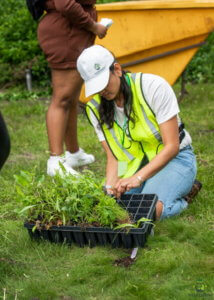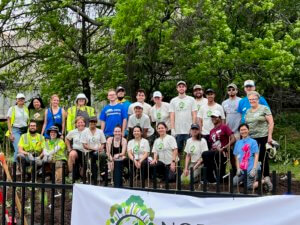Action as an Antidote
The caption on one of my favorite cartoons reads: ”My desire to be well-informed is currently at odds with my desire to remain sane.”
Published in the New Yorker in 2017, David Sipress aptly describes the endless stream of bad news that many of us experience daily in the world of climate change and COVID-19. As a health care worker these past few years, I’ve felt increasingly burdened by this bad news–and I’m not alone. In 2020, nearly one in every five healthcare workers quit. Many of them cited burnout and significant pay cuts with increased risk to their health and the health of their families. For several, this was compounded by a baseline, pre-pandemic state of emotional exhaustion. As stories of worldwide death and devastation from the pandemic swirled around us, we watched patients suffer in front of us. We also saw historic inequalities become glaringly obvious and were acutely reminded of the downstream health impacts of poverty and racism. Though our society initially united to hail our frontline essential heroes, we soon emerged from lockdowns ill-prepared to meet the needs of Americans from different regions, cultures and socio-economic backgrounds.


The kind of cascading chaos we collectively experienced had a distinct impact on those who provided care. In my experience as a primary care physician, the increased corporatization of medicine had already engendered a pre-pandemic level of moral injury. The pandemic only amplified my feelings of being unheard, undervalued and powerless. When my children needed someone at home to help with remote learning, the scales tipped decisively. As difficult and heartbreaking as it was to leave my patients, I had to temporarily shift my focus away from medicine and fully devote it to my family and myself.
The first few months at home came with different challenges. Self-doubt pervaded my thoughts. Who was I now? Was I still a physician? What was my worth if I wasn’t “producing” in the same way? Was I selfish? A quitter? Was I done with medicine? I had pursued a calling–-was I expecting too much from a job?
It took months to answer some of these questions, but with time, I became certain of two things. First, I needed time to heal and regroup. And second, I needed more from any future career.
I fully acknowledge my privilege in being able to briefly step away from seeing patients in a traditional sense and reflect on how best to apply my skills to promote health and well-being. With time, I gained confidence in what my future career could look like. I care about equity. I care about preventative care and health. I care about the environment and vulnerable populations. But, where to start?
I began to see the parallels between the pandemic and the climate crisis: rampant misinformation and disinformation, rejection of scientists and expertise, the risk that people in power would, once again, do too little, too late. What really stuck with me were the stark and frightening perils of health inequity escalating in a future of climate change. As a physician, I had seen how Black and Brown, under-resourced, and historically excluded communities were devastated by the pandemic. I was also coming to see how these same communities were experiencing disproportionate harm from the current climate crisis.
To start, the outdoors was supposed to be safe during a respiratory pandemic. Yet, many Chicago communities near my home had little-to-no safe, accessible greenspace. This is largely explained by historical redlining practices involving government-sponsored segregation and disinvestment. Though redlining has not been legal for decades, affected communities are left with fewer trees today. This lack of greenery, combined with a surplus of buildings, concrete and asphalt causes a heat island effect that is demonstrably worse in previously redlined communities. Urban heat islands contain temperatures several degrees higher than surrounding areas. In certain at-risk populations such as seniors, pregnant women and people who cannot afford to buy or use air conditioners, these few degrees can be the difference between life and death. Increasing evidence has also linked oppressive temperatures to higher aggression, violence and mental fatigue.
These injustices were unacceptable to me, and I became driven to apply my skills to create solutions that advance health and equity. It was a choice that energized me and supported healthy spaces now and for years to come. In May of 2021, I co-founded Nordson Green Earth Foundation (NGEF) with a mission to improve tree and greenspace equity in and around Chicagoland. Just one year later, we planted Illinois’ first tiny, native Miyawaki forest in the city of Markham, with the help of the surrounding community, including 25 local schoolchildren. A few months later, the forest is thriving and supporting pollinators such as bumblebees and butterflies. Our second project, completed this summer, is the creation of an outdoor “Storytime Nook” and Monarch butterfly habitat at the Markham public library. This new installation will encourage more patrons into the library while enhancing early literacy and fostering environmental stewardship. NGEF continues to pursue additional projects that increase connections between people and nature to improve physical, social and mental health. By expanding access to green spaces, NGEF is helping Chicagoland communities to mitigate some of the effects of climate change such as heat islands, biodiversity loss and mental health impacts.


A crucial part of our work is engaging and empowering communities to lead the creation of tiny forests and other accessible greenspaces. Planting trees is one of those activities that forces people to leave their cocooned silos and meet face to face. In a society where we are all too comfortable judging and alienating each other from behind screens, planting trees connects and restores us. It’s hard not to see the good in others when you are crouched shoulder-to-shoulder, digging in the dirt together! Planting trees is for all ages and can be particularly beneficial for children and seniors. It’s easy to find hope and beauty when you can help grow plants, people and ideas.
For me, taking climate action was an antidote. It gave me a much-needed sense of agency and showed me that upstream impact is possible. While this doesn’t make complex and deep-rooted problems like racism any smaller, simply identifying a connection between racist policies and the climate crisis is a necessary start. I now know that I can take dual action on these societal dilemmas, thus improving the health of individuals, strengthening community ties, and reducing future climate impacts. There has been incredible comfort in building a team of like-minded individuals. I have since returned to patient care, but remain grateful for this journey that has allowed me to be a source of change in my local and global communities.
Not everyone can quit their day job. However, tree planting poses a relatively low barrier to entering into climate advocacy. Most cities have tree-planting initiatives.To find them you can contact your local forest preserve, park district or a non-profit such as the Arbor day foundation. If you prefer not to get your hands dirty, you can still help the cause by educating others on the connection between trees, race, health, and climate. You can also persuade your health system to expand their own tree canopy. As clinicians there are simple, accessible forms of advocacy and action we can take that are healing to our communities and to ourselves.
Thinking back to the Sipress cartoon, taking action empowers us to confront challenges that we know are bigger than any one of us alone. With time, even small actions can grow to provide much-needed comfort, refuge and remedy.
About the Author
Dr. Sheetal Khedkar Rao, MS, MD is an internal medicine physician, the co-founder and Chief Health Officer of Nordson Green Earth Foundation, a University of Colorado Climate & Health Science Policy Fellow, and a Climate and Health Fellow at Health Care Without Harm.
Dr. Rao attended medical school at Georgetown University in Washington D.C and completed her internal medicine residency at the University of Illinois at Chicago. She also holds a Bachelors of Science in Chemical Engineering from the University of Illinois at Urbana-Champaign. Dr. Rao has been quoted in the New York Times and The Atlantic on the topic of moral injury in healthcare.